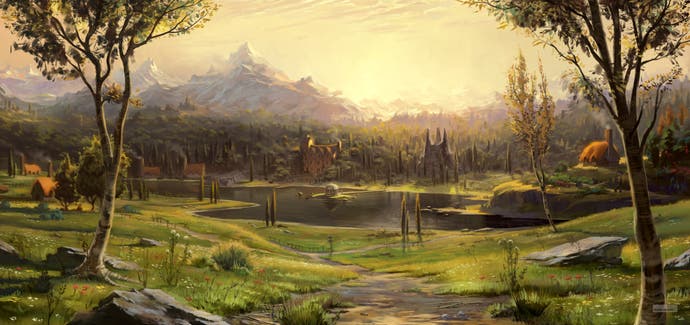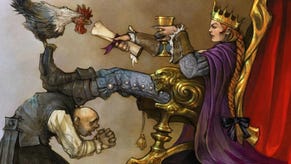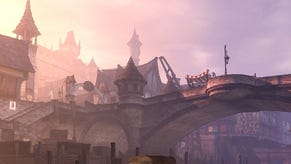Fable III
"A Napoleonic fairytale."
Picture it: the land of Albion in the age of steam. Through the cobbled streets of its towns, crooked houses with slated roofs compete for the afternoon sun with angry eruptions of unlikely machinery, valves match steeples for control of the skyline, and oily goop drips into babbling brooks that run beside fields of already queasy sunflowers.
"You'll see new marvels of the industrial age, devices that the people of Albion are amazed by," enthuses art lead John McCormack. "Half of Bowerstone will be turned into this mass of pistons and steam and clockwork - everything's moving." You'll have to picture it for yourself at the moment, because these are early days for Fable III (a game which, even if it's a disaster, will probably go down in history as the best title ever accidentally announced on Twitter, by Jonathan Ross). Prototypes are up and running deep inside Lionhead's offices, but none of it's ready for the likes of us just yet, unless you're willing to move to Guildford, fake a CV and wing a job as an advanced AI programmer.
A recent chance to sit down with the designers and learn about the early stages of the game's development revealed no hints of Natal, no suggestions if the Milo experiments are bleeding in, no news on what's become of your dog or your trail of breadcrumbs, and no crazy schemes for online modes. The team is willing to give us a tantalising taste of what it is they want to do, but nobody's ready to reveal exactly how it's going to be done.
Instead, there are stories. Stories like this: Several months ago, no matter how many exactly, as Fable II was chugging nicely towards release, a small group gathered in a meeting room at Lionhead. They had come to decide what Fable III would be - and what it wouldn't be. It's a special moment for any game, but particularly poignant for this one: a series that hangs upon choices was having its own mechanics enacted in real life. Perhaps Peter Molyneux even kicked a chicken a good distance at some point during the discussion.
"We started to think about Fable III halfway through Fable II," says McCormack. "You're always thinking about the future, and because of the speed of the industry, you're trying to pre-empt any lag. You get to the end of a game, and hopefully you know what you're doing next already. It's really unfocused at this stage, though, because you don't want to tie yourself down too early. So what we do is we present Peter and the designers with a range of art, a range of things that Fable III could be - all the settings and eras and styles it could be. Anything that tickles your fancy. You put together what you think is a logical progression, but also what you think is a crazy progression, and let the designers and artists work together to choose the best one."
And what they chose, once again, is something of a mish-mash. "The entire Fable idea is a fairytale twist on European history and myth," says McCormack. "What we've settled on is to go about 50 years on from Fable II. So we've loosely chosen the Napoleonic period, and we've started to pull in a bit of Regency, a tiny bit of Victorian, and we're plugging in an early industrial age to Albion. It's a Napoleonic fairytale."

Ships and cannons and troops, metal and rivets and chattering pipework: Fable II was already a game built from details - anyone who ever stopped to watch the hot blast of animation thrown out whenever one of Albion's humble clockwork doors got ready to open will know that - and this tentatively mechanised environment is a proposition that sounds entirely fitting, even if it promises to significantly alter the familiar environments. "There's still a consistency," offers McCormack. "We never want to be photorealistic. The art style is: never put in straight lines, never use a right-angle, always break shades into opposing colours. There's rules within the art that hopefully turn it into a fairytale no matter where we go. I think we solidified the style with Fable II; with Fable III, we've nailed it.
"We've moved it forward. Think of the monsters: industrialisation has pushed the fairytale creatures underground, and to the edges of the forests. You'll go there, and they're still around, but they're not happy about it this time. Albion's still full of mystery and wonder, but it's more aggressive: the ancient creatures don't like to be shoved away."
The shift in period is not just an aesthetic choice, then: the landscape is telling a story, and the story itself is typically rooted in the series' fascinations with choices and morality. "There's some mad stuff coming in," laughs McCormack, unwittingly sketching designs in the air with his hand. "One of the main themes here is how the advancement of the new world is having an adverse effect on the beautiful lush environments of Albion. Industrialisation is changing Albion, and do you want to put a stop to that?"
Don't expect an easy decision, though: Lionhead isn't pretending that the wonders and horrors of the modern era aren't knotted tightly together. "We're interested in how industry can destroy nature, but also how it can create ships and balloons and cable-cars that take you farther afield and to other lands. It's about colonisation and travel as well. You're expanding the world by introducing industrialisation, but there's always that darker side, and that's war. You're producing war machines and militarising the population."
War? Sounds nasty. "I'm terrified," says Peter Molyneux, looking tanned, rested, and distinctly unterrified. "The third time out is tricky. This is where it could all go wrong." He leans back in his chair and spreads his arms wide, as if to show us there's nothing up his sleeves. "This is where it could all... go... wrong."









